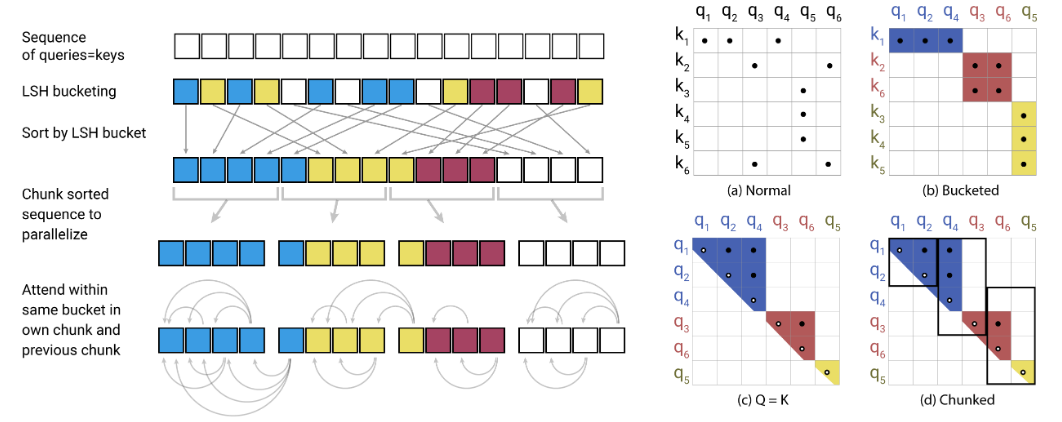This is a Pytorch implementation of Reformer https://openreview.net/pdf?id=rkgNKkHtvB
It includes LSH attention, reversible network, and chunking. It has been validated with an auto-regressive task (enwik8). It also includes additional features to make the entire network pure attention all the way down.
81k tokens with half precision
$ pip install reformer_pytorchA simple Reformer language model
# should fit in ~ 5gb - 8k tokens
import torch
from reformer_pytorch import ReformerLM
model = ReformerLM(
num_tokens= 20000,
dim = 1024,
depth = 12,
max_seq_len = 8192,
heads = 8,
lsh_dropout = 0.1,
emb_dim = 128, # embedding factorization for further memory savings
causal = True, # auto-regressive or not
bucket_size = 64, # average size of qk per bucket, 64 was recommended in paper
n_hashes = 4, # 4 is permissible per author, 8 is the best but slower
ff_chunks = 200, # number of chunks for feedforward layer, make higher if there are memory issues
weight_tie = False, # tie parameters of each layer for no memory per additional depth
attn_chunks = 8, # process lsh attention in chunks, only way for memory to fit when scaling to 16k tokens
num_mem_kv = 128, # persistent learned memory key values, from all-attention paper
twin_attention = False, # both branches of the reversible network will be attention
use_full_attn = False, # use full self attention, for comparison
full_attn_thres = 1024, # use full attention if context length is less than set value
use_scale_norm = False # use scale norm from 'Transformers without tears' paper
).cuda()
x = torch.randint(0, 20000, (1, 8192)).long().cuda()
y = model(x) # (1, 8192, 20000)The Reformer (just a stack of reversible LSH attention)
# should fit in ~ 5gb - 8k embeddings
import torch
from reformer_pytorch import Reformer
model = Reformer(
dim = 512,
depth = 12,
max_seq_len = 8192,
heads = 8,
lsh_dropout = 0.1,
causal = True
).cuda()
x = torch.randn(1, 8192, 512).cuda()
y = model(x) # (1, 8192, 512)Self Attention with LSH
import torch
from reformer_pytorch import LSHSelfAttention
attn = LSHSelfAttention(
dim = 128,
heads = 8,
bucket_size = 64,
n_hashes = 8,
causal = False
)
x = torch.randn(10, 1024, 128)
y = attn(x) # (10, 1024, 128)LSH (locality sensitive hashing) Attention
import torch
from reformer_pytorch import LSHAttention
attn = LSHAttention(
bucket_size = 64,
n_hashes = 16,
causal = True
)
qk = torch.randn(10, 1024, 128)
v = torch.randn(10, 1024, 128)
out, attn, buckets = attn(qk, v) # (10, 1024, 128)
# attn contains the unsorted attention weights, provided return_attn is set to True (costly otherwise)
# buckets will contain the bucket number (post-argmax) of each token of each batchA full Reformer sequence → sequence, say translation
import torch
from reformer_pytorch import ReformerLM
DE_SEQ_LEN = 4096
EN_SEQ_LEN = 4096
encoder = ReformerLM(
num_tokens = 20000,
emb_dim = 128,
dim = 1024,
depth = 12,
heads = 8,
max_seq_len = DE_SEQ_LEN,
fixed_position_emb = True,
return_embeddings = True # return output of last attention layer
).cuda()
decoder = ReformerLM(
num_tokens = 20000,
emb_dim = 128,
dim = 1024,
depth = 12,
heads = 8,
max_seq_len = EN_SEQ_LEN,
fixed_position_emb = True,
causal = True
).cuda()
x = torch.randint(0, 20000, (1, DE_SEQ_LEN)).long().cuda()
yi = torch.randint(0, 20000, (1, EN_SEQ_LEN)).long().cuda()
enc_keys = encoder(x) # (1, 4096, 1024)
yo = decoder(yi, keys = enc_keys) # (1, 4096, 20000)A full Reformer image → caption
import torch
from torch.nn import Sequential
from torchvision import models
from reformer_pytorch import Reformer, ReformerLM
resnet = models.resnet50(pretrained=True)
resnet = Sequential(*list(resnet.children())[:-4])
SEQ_LEN = 4096
encoder = Reformer(
dim = 512,
depth = 6,
heads = 8,
max_seq_len = 4096,
)
decoder = ReformerLM(
num_tokens = 20000,
dim = 512,
depth = 6,
heads = 8,
max_seq_len = SEQ_LEN,
causal = True
)
x = torch.randn(1, 3, 512, 512)
yi = torch.randint(0, 20000, (1, SEQ_LEN)).long()
visual_emb = resnet(x)
b, c, h, w = visual_emb.shape
visual_emb = visual_emb.view(1, c, h * w).transpose(1, 2) # nchw to nte
enc_keys = encoder(visual_emb)
yo = decoder(yi, keys = enc_keys) # (1, 4096, 20000)To access the attention weights and bucket distribution, simply wrap the instantiated model with the Recorder wrapper class.
import torch
from reformer_pytorch import Reformer, Recorder
model = Reformer(
dim = 512,
depth = 12,
max_seq_len = 8192,
heads = 8,
lsh_dropout = 0.1,
causal = True
).cuda()
model = Recorder(model)
x = torch.randn(1, 8192, 512).cuda()
y = model(x)
model.recordings[0] # a list of attention weights and buckets for the first forward pass
model.turn_off() # stop recording
model.turn_on() # start recording
model.clear() # clear the recordings
model = model.eject() # recover the original model and remove all listeners- Zachary Bloss has kindly added code for training GLUE under
examples/glue
Make it so Reformer can be used as decoder where queries only attend to fed key/valuesAll-attention learned memory key valuesOption to switch to full shared-qk attention at shorter sequence lengths (< 2048 or a set threshold)- Recurrence like Transformer XL
@inproceedings{kitaev2020reformer,
title = {Reformer: The Efficient Transformer},
author = {Nikita Kitaev and Lukasz Kaiser and Anselm Levskaya},
booktitle = {International Conference on Learning Representations},
year = {2020},
url = {https://openreview.net/forum?id=rkgNKkHtvB}
}@article{DBLP:journals/corr/abs-1907-01470,
author = {Sainbayar Sukhbaatar and
Edouard Grave and
Guillaume Lample and
Herv{\'{e}} J{\'{e}}gou and
Armand Joulin},
title = {Augmenting Self-attention with Persistent Memory},
journal = {CoRR},
volume = {abs/1907.01470},
year = {2019},
url = {http://arxiv.org/abs/1907.01470}
}@article{1910.05895,
author = {Toan Q. Nguyen and Julian Salazar},
title = {Transformers without Tears: Improving the Normalization of Self-Attention},
year = {2019},
eprint = {arXiv:1910.05895},
doi = {10.5281/zenodo.3525484},
}